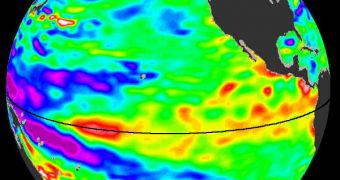Over the past couple of decades, the connection of human activities with increased global temperatures has been proven beyond a reasonable doubt. Pollution and greenhouse gas emissions have created a warming effect on the world, which is currently experiencing a rise in sea levels, caused primarily by melting glaciers, and a shift in climate patterns. But, while humans play a primary role in this, the world's oceans also contribute to the warming. Their ability to store heat for prolonged periods of time was one of the main contributor to the increased temperatures we experienced in 2009, and experts say that they are likely to promote this temperature trend in 2010 as well.
What many people fail to realize is that the oceans act like a planetary thermostat. They are capable of storing energy from the Sun, thus enabling the planet to experience only moderate climate change. This is possible because the water covers about 71 percent of the global surface. They also contribute to changing the climate, but researchers argue that they are more of a tempering force than a driver. In other words, without these oceans, we would be experiencing more sudden and abrupt changes in climate and temperatures. According to calculations, the first three meters of ocean depth hold just as much energy from the Sun as the entire atmosphere does.
“The vast amount of heat stored in the ocean regulates Earth's temperature, much as a flywheel regulates the speed of an engine. The ocean has a long history of capturing and giving up heat generated by both human activities and natural cycles; it is the thermal memory of the climate system,” explains oceanographer and climatologist Bill Patzert, who is based at the NASA Jet Propulsion Laboratory (JPL), in Pasadena, California. The interactions between the water and the atmosphere are the object of an entire range of studies, ranging from the ones conducted by satellites such as the European Space Agency's SMOS to direct measurement taken at their interface.
“These interactions result in large-scale global climate effects, the largest of which is the El Nino – Southern Oscillation,” JPL oceanographer and climate scientist Josh Willis adds. He explains that this climate pattern can have a severe influence on the global atmospheric patterns. Weather worldwide is affected by El Nino, for example in terms of how many hurricanes form in a single area. Droughts and floods are also regulated by these events, as are global temperatures. The climate pattern can easily drive temperatures up by as much as 0.2 degrees Celsius, or 0.4 degrees Fahrenheit. Many global warming skeptics say that this isn't much, but experts have determined that a 2-degree-Celsius increase is enough to cause serious repercussion on the ice caps of Greenland, the Arctic and Antarctica.
“These natural climate phenomena can sometimes hide global warming caused by human activities, or they can have the opposite effect of accentuating it,” Willis adds. “These natural signals can modulate the global record for a decade or two, giving us a wild ride with major climate and societal impacts. They can have a powerful short-term influence on global temperatures in any particular year or decade. This can make it appear as if global warming has leveled off or become global cooling. But when you look at the long-term trend over the past 130 years, our world is definitely getting warmer. And that's the human-produced greenhouse gas signal,” Patzert concludes.

 14 DAY TRIAL //
14 DAY TRIAL //